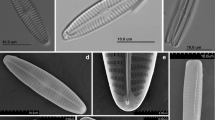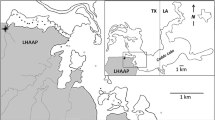Abstract
The results of two newly developed sediment toxicity tests were compared to the standard, 48-h acute Daphnia magna and Ceriodaphnia dubia tests. The 14-day Hyalella azteca growth inhibition test is a definitive test of chronic exposure to toxic sediments. The rapid, fluorescent D. magna test, which is based on in vivo inhibition of enzymatic processes, has been suggested as a rapid screening tool. H. azteca mortality was the least sensitive bioassay endpoint, while H. azteca growth, D. magna fluorescence, C. dubia mortality, and D. magna mortality were equally sensitive to the effects of sediments spiked with CuSO4. In sediments collected in copper-contaminated lakes, the standard, acute 48-h D. magna bioassay was the least sensitive test, while the D. magna fluorescence test and H. azteca growth reduction test were the most sensitive bioassays.
Similar content being viewed by others
References
APHA (1985) Standard methods for the examination of water and wastewater. 16th edition. American Public Health Association, Washington, DC 1268 pp
Allen HE, Fu G, Deng B (1993) Analysis of acid-volatile sulfide (AVS) and simultaneously extracted metals (SEM) for the estimation of potential toxicity in aquatic sediment. Environ Toxicol Chem 12:1441–1453
Allen HE, Fu G, Boothman W, Di Toro DM Mahoney JD (1991) Determination of acid volatile sulfide and selected simultaneously extractable metals in sediment. Office of Water Regulations and Standards, US Environmental Protection Agency, Washington, DC 18 pp
Ankley GT, Mattson VR, Leonard EN, West CW, Bennett JL (1993) Predicting the acute toxicity of copper in freshwater sediments: Evaluation of the role of acid volatile sulfide. Environ Toxicol Chem 12:315–320
Borgmann U, Munawar M (1989) A new standardized sediment bioassay protocol using the amphipod Hyalella azteca (Saussure). Hydrobiologia 188/189:425–531
Borgmann U, Ralph KM, Norwood WP (1989) Toxicity test procedures for Hyalella azteca, and chronic toxicity of cadmium and pentachlorophenol to H. azteca, Gammarus fasciatus, and Daphnia magna. Arch Environ Contam Toxicol 18:756–764
Cairns MA, Nebeker AV, Gakstatter JH, and Griffiths WL (1984) Toxicity of copper-spiked sediments to freshwater invertebrates. Environ Toxicol Chem 3:435–445
DeMott WR (1986) The role of taste in food selection by freshwater zooplankton. Oeco (Berlin) 69:334–340
Di Toro DM, Mahoney JH, Hansen DJ, Scott KJ, Hicks MB, Mayr SM, Redmond M (1990) Toxicity of cadmium in sediments: The role of acid volatile sulfides. Environ Toxicol Chem 9:1485–1502
Elnabarawy MT, Robideau RR, Beach SA (1988) Comparison of three rapid toxicity test procedures: Microtox, Polytox and activated sludge respiration inhibition. Toxicol Assess 3:81–91
Evans ED, Wilson M, Creal W (1991a) Assessment of mercury contamination in selected Michigan lakes. 1987–1990: Historical trends, environmental correlates, and potential sources. Report number SWQ-91/106, Michigan Dept Nat Res Surface Water Quality Division, Lansing, MI, 82 pp
—, —, — (1991b) Mean concentrations of selected sediment parameters from Michigan lakes, 1987–1990 lake survey. Unpublished data. Michigan Dept Nat Res Surface Water Quality Division, Lansing, MI
Fu G, Allen HE, Cao Y (1992) The importance of humic acids to proton and cadmium binding in sediments. Environ Toxicol Chem 11:1363–1372
Geisler FS (1944) Studies on the post-embryonic development of Hyalella azteca (Saussure). Biol Bull (Woods Hole, MA) 86:6–22 PG
Giesy JP, Hoke RA (1989) Freshwater sediment toxicity bioassessment: Rationale for species selection and test design, J Great Lakes Res 15:539–569
Giesy JP, Newsted JL, Rosiu CJ, Benda A, Kries RG, Horvath FJ (1988) Comparison of three sediment bioassay methods using Detroit River sediment. Environ Toxicol Chem 7:483–498
Hamilton MA, Russo RC, Thurston RV (1977) Trimmed Spearman-Karber method for estimating median lethal concentrations in toxicity bioassays. Environ Sci Technol 11:714–719. Correction 12:417 (1978)
Janssen CR, Persoone G (1993) Rapid toxicity screening tests for aquatic biota. 1. methodology and experiments with Daphnia magna. Environ Toxicol Chem 12:711–717
Janssen CR, Espiritu EQ, Persoone G (1993) Evaluation of new “enzyme inhibition” criterion for rapid toxicity testing with Daphnia magna. In: Soares S, Calow P (eds) Progress in standardization of aquatic toxicity tests. Lewis, Ann Arbor, MI pp 71–80
Kubitz JA (1994) Development of a sediment toxicity test using the amphipod Hyalella azteca. PhD Dissertation, Michigan State University, East Lansing, MI, 190 pp
Leweke EC (1993) A study of bio-fluorescent substances for rapid assessment of the effects of contaminated aquatic sediments on invertebrates. MS Thesis. University of Aachen, Aachen, Germany, 62 pp
Markham T (1985) Stamp sands and chemical reagents of Torch Lake mills. MS Thesis. Michigan Technological University, Houghton, MI
Nebeker AV, Cairns MA, Gakstatter JH, Malueg KW, Schuytema GS, Krawczyk DF (1984) Biological methods for determining toxicity of contaminated freshwater sediments to invertebrates. Environ Toxicol Chem 3:617–630
Schubauer-Berigan, MK, Dierkes, JR, Monson, PD Ankley, GT (1993) pH-dependent toxicity of Cd, Cu, Ni, Pb and Zn to Ceriodaphnia dubia, Pimephales promelas, Hyalella azteca and Lumbriculus variegatus. Environ Toxicol Chem 12:1261–1266
West CW, Mattson VR, Leonard EN, Phipps GL, Ankley GT (1993) Comparison of the relative sensitivity of three benthic invertebrates to copper-contaminated sediments from the Keweenaw Waterway. Hydrobiologia 262:57–63
United States Environmental Protection Agency (1985) Methods for measuring the acute toxicity of effluents to fresh water and marine organisms. EPA/600/4–85/013, US EPA ORD EMSL Cincinnati, OH, 216 pp
Author information
Authors and Affiliations
Rights and permissions
About this article
Cite this article
Kubitz, J.A., Lewek, E.C., Besser, J.M. et al. Effects of copper-contaminated sediments on Hyalella azteca, Daphnia magna, and Ceriodaphnia dubia: Survival, growth, and enzyme inhibition. Arch. Environ. Contam. Toxicol. 29, 97–103 (1995). https://doi.org/10.1007/BF00213093
Received:
Revised:
Issue Date:
DOI: https://doi.org/10.1007/BF00213093




